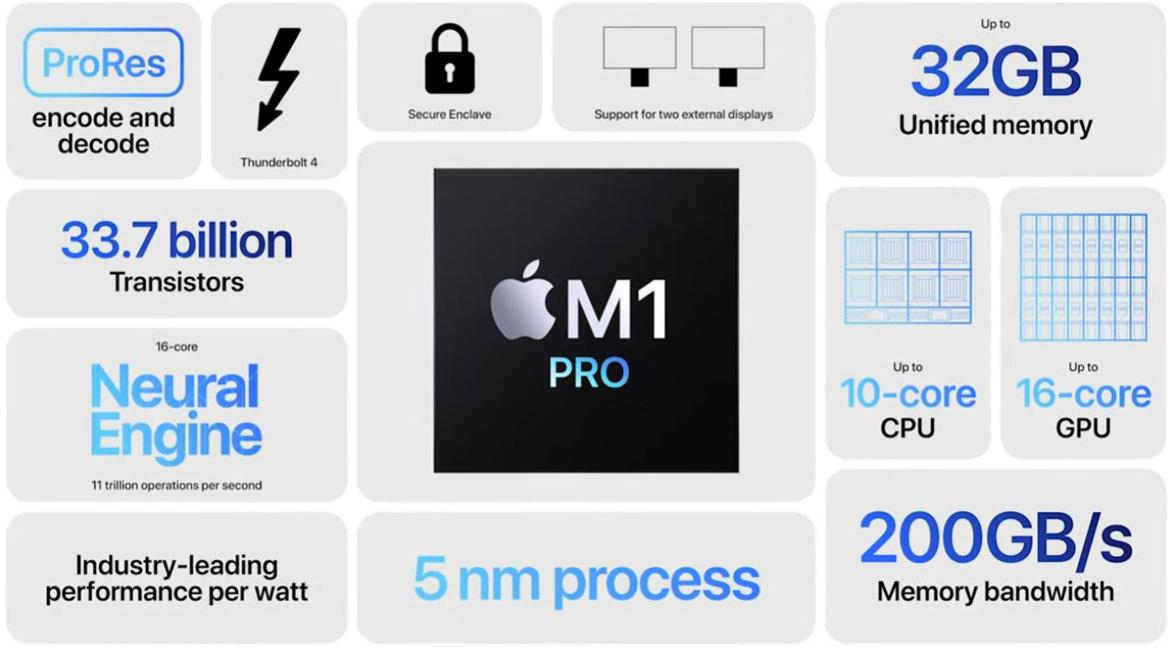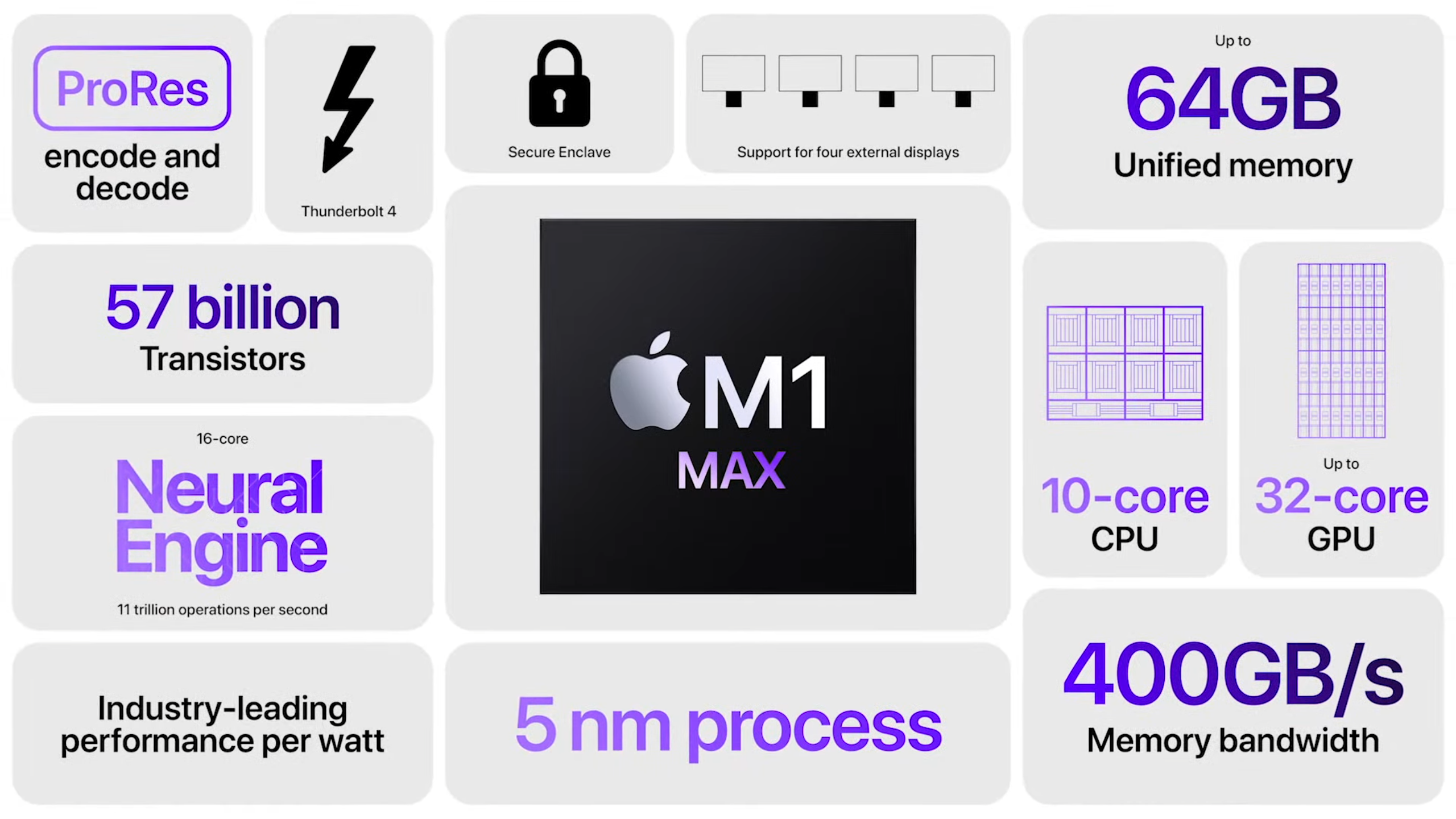Apple's 10-Core M1 Pro, M1 Max CPUs Pack Up to 32-Core GPU, 64GB RAM
The M1 Pro and M1 Max offer a big leap in performance over the M1.
Apple today announced its next-generation SoC family designed specifically for its all-new MacBook Pro family, confirming the previous rumors. The M1, which launched late last year, is being joined by the M1 Pro and the M1 Max. Like the entry-level M1, the more powerful M1 Pro and M1 Max are built on an enhanced 5nm process node.
Starting things off is the M1 Pro. Apple claims that this new SoC doubles the width of the memory interface, delivering a total of 200 GBps of bandwidth (shared between the CPU and the GPU). This is a 3x uplift compared to M1. According to Apple, the M1 Pro is comprised of 33.7 billion transistors, which is 2x greater than what you’d find in the M1.
Apple is of course touting performance superiority over comparable Intel laptops (which we'll have to verify), saying that the M1 Pro is 1.7x faster than "the latest 8-core PC laptop chip" while consuming 70 percent less power. Confirming the earlier rumors, the M1 Pro uses up to a 10-core CPU (8 performance cores, 2 efficiency cores) along with a 16-core GPU. The GPU, which features 2,048 execution units, delivers doubles the performance over the M1. MacBook Pro systems with the M1 Pro can be configured with up to 32GB of RAM. Interestingly, the base 14-inch MacBook Pro comes with an M1 Pro equipped with 8 CPU cores and 14 GPU cores.
| Header Cell - Column 0 | M1 | M1 Pro | M1 Max |
|---|---|---|---|
| Process Node | 5nm | 5nm | 5nm |
| Transistors | 16 billion | 33.7 billion | 57 billion |
| CPU Cores | 8 | 8 or 10 | 10 |
| GPU Cores | 7 or 8 | 14 or 16 | 24 or 32 |
| Memory Bandwidth | 68.25 GBps | 200 GBps | 400 GBps |
| Maximum Memory | 16GB | 32GB | 64GB |
But Apple isn’t stopping there; it also announced the flagship M1 Max SoC, which doubles total memory bandwidth over the M1 Pro to 400 GBps. The number of transistors onboard also swells to 57 billion transistors, while up to 64GB of RAM can be configured. That sharp increase in transistors can be partially attributed to the GPU, which jumps from 16 cores to a maximum of 32 cores (also doubling execution units to 4,096). The M1 Pro will reportedly deliver a 4x increase in graphics performance over the original M1. As for the CPU, it reportedly offers comparable performance to the Razer Blade 15 Advanced, while sipping 40 percent less power.
As for the new MacBooks, the 14-inch MacBook Pro sports a 3024 x 1964 resolution display, while its 16-inch counterpart ups that to 3456 x 2234. Both displays feature dynamic refresh rates of up to 120 Hz. As previously rumored, the Touch Bar is gone. However, users do gain MagSafe power, a full-size HDMI port, and an SD slot to go along with three Thunderbolt ports.
Pricing for the new MacBook Pros, which should compete effectively with the best ultrabooks and premium laptops, starts at $1,999, with preorders opening up today.
Get Tom's Hardware's best news and in-depth reviews, straight to your inbox.

Brandon Hill is a senior editor at Tom's Hardware. He has written about PC and Mac tech since the late 1990s with bylines at AnandTech, DailyTech, and Hot Hardware. When he is not consuming copious amounts of tech news, he can be found enjoying the NC mountains or the beach with his wife and two sons.
-
truerock The new Apple notebook PCs have 3 Thunderbolt 4.0 ports and an HDMI port. I'm guessing the HDMI port is an adapter of the 4th Thunderbolt 4.0 port (Thunderbolt ports come in pairs).Reply
I guess their are a lot of obsolete HDMI monitors and TVs around - enough to make changing a Thunderbolt 4.0 USB-C port into an HDMI port. I guess you could buy an adapter to make the HDMI port into a Thunderbolt 4.0 USB-C port (like if you have a video monitor with a Thunderbolt 4.0 USB-C port). -
TinyFatMan AMD (Advanced Micro Devices) Revenue $9.76 billionReply
Apple Revenue US$274.515 billion (2020)
nVidia Revenue US$10.92 billion (2020)
Where are AMD processors manufactured?
Taiwan Semiconductor Manufacturing Company (TSMC)
Where does Apple manufacture their processors?
Taiwan Semiconductor Manufacturing Company (TSMC)
Who manufactures Nvidia GPUs?
Taiwan Semiconductor Manufacturing Company (TSMC)
So, is it a "coincidence" the "lack" of electronic chips for graphics cards from AMD and nVidia? -
JamesJones44 Replytruerock said:The new Apple notebook PCs have 3 Thunderbolt 4.0 ports and an HDMI port. I'm guessing the HDMI port is an adapter of the 4th Thunderbolt 4.0 port (Thunderbolt ports come in pairs).
I guess their are a lot of obsolete HDMI monitors and TVs around - enough to make changing a Thunderbolt 4.0 USB-C port into an HDMI port. I guess you could buy an adapter to make the HDMI port into a Thunderbolt 4.0 USB-C port (like if you have a video monitor with a Thunderbolt 4.0 USB-C port).
I don't think it has to due with removing the need for the adapter. I think it has to due to it supporting the full HDMI 2.1 specification. Thunderbolt 4 maxes out at 40 Gbps while the full HDMI 2.1 spec requires 48 Gbps, thus no adapter for TB4 can do full HDMI 2.1.
Edit: Well turns out my reasoning for the port was not Apple's... The port is limited to HDMI 2.0b, so this move by Apple to add HDMI for no really good reason is a little weird, but shrug. -
JamesJones44 ReplyTinyFatMan said:AMD (Advanced Micro Devices) Revenue $9.76 billion
Apple Revenue US$274.515 billion (2020)
nVidia Revenue US$10.92 billion (2020)
Where are AMD processors manufactured?
Taiwan Semiconductor Manufacturing Company (TSMC)
Where does Apple manufacture their processors?
Taiwan Semiconductor Manufacturing Company (TSMC)
Who manufactures Nvidia GPUs?
Taiwan Semiconductor Manufacturing Company (TSMC)
So, is it a "coincidence" the "lack" of electronic chips for graphics cards from AMD and nVidia?
Apple paid up for priority access to TMSCs best node, it's why a lot of TMSC chips are not just starting to ship on their 5nm node while Apple has been doing for a year already. So to answer your question, it's not coincidence, it's deep pockets and over reliance on a single manufacture. -
spongiemaster Reply
Not a coincidence. Not relevant either. TSMC only manufactures Nvidia's professional lines. Those have not experienced wide spread shortages because they aren't used for mining. Samsung manufactures Nvidia's gaming GPU's.TinyFatMan said:Who manufactures Nvidia GPUs?
Taiwan Semiconductor Manufacturing Company (TSMC)
So, is it a "coincidence" the "lack" of electronic chips for graphics cards from AMD and nVidia? -
gggplaya ReplyTinyFatMan said:AMD (Advanced Micro Devices) Revenue $9.76 billion
Apple Revenue US$274.515 billion (2020)
nVidia Revenue US$10.92 billion (2020)
Where are AMD processors manufactured?
Taiwan Semiconductor Manufacturing Company (TSMC)
Where does Apple manufacture their processors?
Taiwan Semiconductor Manufacturing Company (TSMC)
Who manufactures Nvidia GPUs?
Taiwan Semiconductor Manufacturing Company (TSMC)
So, is it a "coincidence" the "lack" of electronic chips for graphics cards from AMD and nVidia?
Apple's current chips are in the 5nM production line whereas AMD and Nvidia are still on 7nM. Also, Nvidia's consumer graphics cards are made on the Samsung 8nM factory because each wafer is cheaper though, yield and transistor density appear to be lower. -
Alvar "Miles" Udell And don't forget your official Apple Polishing Cloth straight from the Apple store for $19! And you thought a $999 monitor stand was the biggest joke...Reply
https://www.apple.com/shop/product/MM6F3AM/A/polishing-cloth -
excalibur1814 Apple: Buy our computers. They rock.Reply
Apple: Buy our NEW Intel computers. They rock. The old stuff sucked.
Apple: Buy our NEW M1 computers. They rock. The old stuff sucked.
Suckers and their money... .
(Although I cannot deny that they've done a great job and that they are great).
P.s. " obsolete HDMI monitors " - Umm, they're pretty much ALL HDMI monitors in this building. -
Matt_ogu812 ReplyTinyFatMan said:AMD (Advanced Micro Devices) Revenue $9.76 billion
Apple Revenue US$274.515 billion (2020)
nVidia Revenue US$10.92 billion (2020)
Where are AMD processors manufactured?
Taiwan Semiconductor Manufacturing Company (TSMC)
Where does Apple manufacture their processors?
Taiwan Semiconductor Manufacturing Company (TSMC)
Who manufactures Nvidia GPUs?
Taiwan Semiconductor Manufacturing Company (TSMC)
So, is it a "coincidence" the "lack" of electronic chips for graphics cards from AMD and nVidia?
The 'In Your Face' pitfalls of Sole Source Sourcing.
We can only hope that lessons are being learned from all of this.

